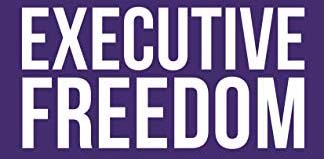Would your personality suit part-time director roles?
20 May 2019 By Victoria Tomlinson

Someone in our network recommended this book, Executive Freedom – he is a part-time IT director for smaller businesses and part of the Liberti Group behind this book.
Before I go further, I should say the book is well written and has interesting insights for our Next-Up audience – but I was also slightly irritated that I paid £7 for a book that is a big sales pitch for their company all the way through!
That said, I thought I would share their analysis of the personality virtues that they say make for a really good part-time director. Reading them, I thought these virtues – as they call them – actually apply to anyone forging a new career on their own, whether as a non-executive director, trustee, consultant, advisor or more.

You need to be humble
The authors, Colin Mills and Sarah Daw, say “This is not a lifestyle where large egos win the day. Parking your ego at the door on the way into a client can be challenging for a corporate executive entering the portfolio industry – especially when working with SME clients…..
“It doesn’t matter how good you were as a corporate executive or what big-name companies you have worked for. When you are building a portfolio it’s no longer about you – it’s about your client and what you can do for them.”
This is so true and reminds me of two business owners I have known over the years who took on directors from global brands. Both ran significant smaller businesses in completely different fields and both were really excited to have recruited such amazing people – they thought these directors would transform their businesses, the business owners would learn so much from them and more.
The difficulty for the new directors was they were used to pontificating and having teams around them to do the actual work. They weren’t able to get back to basics, roll up their sleeves and apply their experience to a small business.

It took nearly a year for both these business owners to recognise they had made a massive mistake – they were both slightly in awe of their new directors and it took a while to take the rose-tinted spectacles off.
As Colin and Sarah say, “There is nothing wrong with having confidence in yourself and your skill set. But the best performers in the portfolio space are much more interested in fitting in and figuring out what business issues the client wants solved.”
And I would add – and solving them!
Givers are more successful than takers
Quoting Adam Grant’s book Give and Take, they say people who give without expecting anything in return are more successful in the longer term. This is one of the fundamentals of good networking – and life in general.
Too often they found their part-time directors were waiting to be given work first before referring work out, when if you are the first to give work out then you tend to be the one getting more referrals back.
You need to be networked
Working with our Next-Up clients I am discovering that most of their networks tend to be within their company/firm, with their boards, within their industry bodies. But they have quite a narrow network to build anything from once they are on their own.
There is also the point that for people at the top of their game, their network tends to be older and these people will also be leaving corporate life too, in the near future. You have to make a real effort to network with all sorts and ages of people.
Having said that, I have worked with a few people who set up consultancies and they had networked like mad in their local communities – Chambers of Commerce, business associations etc. After a year or two they realised these small businesses were great in terms of general support and having people to share problems/ideas with – but they were never going to use them for their skills, or pay the rates they wanted.
So they had to learn to be strategic in their networking and start targeting people in a focused way – probably through LinkedIn and contacts.
It’s all about the relationship
“Relationships take time to develop into what you want them to be,” say the authors. “But working at them over time is the smart way to build a continual flow of referrals’.
They include a reminder that ‘people buy from people’ and it takes time to get to know someone to give them work.
There is the famous maxim, ‘it takes seven touches to sell’ and you have to keep working at the relationship until someone buys from you. This blog, 3 amazing ways to generate B2B sales leads, that I wrote years ago, explains more about the principle.
You have to be a learner
“Anyone who thinks they are too old or too good to learn anything new is probably not right for this world of work,” say the authors.
I have a passion about the need for this experienced generation to keep learning – and particularly to understand what is happening around technology/disruption. My own view is that anyone in any kind of advisory role – part-time director roles, non-executive directors, trustees, consultants etc – will be there to look at strategy and risk as a key part of this. And disruption is – strategy and risk.
I have heard so many senior people say ‘I don’t do tech’ – almost proudly – but if that is their attitude they are failing the organisations they advise and, frankly, themselves. If they want to be relevant for the next five, ten or 15 years then they have to learn more.

You need to be hungry
The authors say, “You can’t afford to sit and wait for the phone to ring: you have to go out and do the things that are going to grow your business”.
Sadly, when people leave a career at the top of their game, there is an expectation they will be ‘tapped on the shoulder’.
The authors’ advice is, ‘Be active, be active, be active’ – but on the right things. They advise having 16 meetings a week – four a day from Monday to Thursday – with Fridays for catch-up and follow-up. With each meeting ask for a referral to two more people who could help you build your network. You don’t have to ask these people for business itself – you can say it is to test out your ideas, understand a market, understand who might buy your services – but if you are any good, you should start getting business from some of the meetings. If not, then you aren’t meeting the right people.
So those are the virtues they see as the core to being successful as a part-time director – and I would extend to any kind of advisory role after full-time working life.
The book is worth reading for anyone embarking on a portfolio career and once you get beyond the running sales pitch in the book, there are good, practical tips as well as insights.


